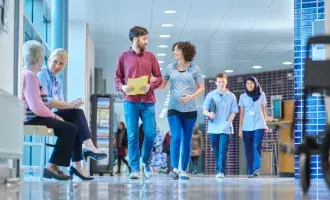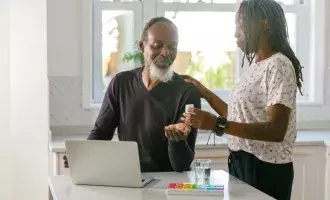Over the past year our relationship with technology has rapidly transformed, with the pandemic disrupting the way we live, work and communicate with one another.
It’s pushed the government, local authorities, businesses and organisations across all sectors in the UK and abroad to adopt new technology at a faster pace. Meanwhile, it’s also accelerated a wider roll-out of existing technology, the adoption of emerging solutions (such as artificial intelligence (AI) and autonomous machines), as well as the development of new processes and ways of working. Businesses have been forced to start looking into new, alternative and more innovative business and operating models. Moving at this unprecedented pace has allowed us to overcome some long-lasting barriers, reducing scepticism around the adoption of new technology and showing some of the positive outcomes that can now be uncovered.
The opportunities to build back ‘smarter’ places, in rural and urban areas are endless, but there are also challenges to tackle. While we recognise that many aspects of the real world can never be replaced, the pandemic has been a learning tool for how quickly and efficiently technology can revolutionise services and habits. Building back smarter means using the opportunities provided by technology and innovation with a creative, holistic and collaborative mindset. The places and services of the future need to put the user first, ensuring that both the environment and local heritage are protected.
What are the limitations?
Digital habits have been adapting for the past decade, with people steadily increasing their reliance on tools such as online banking, shopping and mobile apps. Since the lockdowns, trust in digital tools has increased consistently, along with people’s willingness to use online services for everything from gym sessions to cultural experiences. For some people, particularly those who live in rural areas or struggle with long-term illness, this wealth of online options could trigger the design and provision of new meaningful services.
When things happen at such a fast pace it can be hard to spot immediate challenges, foresee the ones that may arise, and intervene in the right way. Whilst the pandemic has forced a reactive acceleration of the digital transformation, we now need to work together to drive this in a strategic and proactive way. It will be paramount that places, services and systems guarantee safety and security to people and communities, so that the growing trust in technology can be maintained. It’s also important to remember that while most people use the internet, not everyone is digitally savvy. That’s why we must design and deliver inclusive solutions and services, especially during this transition period, where people have differing approaches to digital tools. This will involve a hybrid, cross-generational approach, to include people who prefer to communicate via offline channels. We’ll need to avoid using technology for the sake of it and ensure that it’s used mindfully to create the best outcomes for people and communities. There is also a need to upskill professionals across various sectors and disciplines. Whilst technology has the potential to solve some local and global challenges, enabling communities to build and regenerate goes beyond these tools. We need to change the culture of how we work, to ensure we can build a joint ecosystem together.
What does the future look like?
We’ve already seen great advances in the way technology is being used but there is much more to do. Central government and local authorities will be able to use technology, data and analytics to gain insights that will help them to improve strategic decision-making processes and plan for the future in a more informed way. Organisations across various sectors will be able to use advanced technology to further optimise and automate processes, making operations and maintenance more efficient and sustainable. Meanwhile, services that can adapt to real time circumstances, disruptions and needs will be able to provide a better user experience. As virtual technology improves, it will make it easier than ever before for people to access remote support and advice. We’re also expecting to see a greater emphasis on training events and local initiatives to increase digitisation across communities.
Getting there
In the past digital transformation has been quite siloed, with each sector focusing on its own needs. The goal is to work towards smart cities or communities, where different sectors of society can be truly integrated. This will mean removing barriers to integration, such as poor knowledge and understanding of digital systems. We also hope to see data become more accessible, to help us better understand the needs of individuals.
As the lockdown lifts, certain industries are likely to struggle more than others. In order to build back well, we’ll need to make sure that people have access to the tools and training they need to gain new skills in other areas. For example, someone who was previously working in a shop could train to manage online local marketplaces, or another area that’s seen a growing demand. Local authorities will need to consider not just what’s cost effective, but also what’s best for the community in the long-term. Decisions will need to be made based on the entire demographics of the population, which may mean initiatives will differ across the country. By working together across all sectors and ensuring nobody is left behind, we can make the most of this new opportunity to build back smarter. A holistic approach that prioritises inclusion and diversity will be essential to society’s success. The beauty of a town centre is in the eye of the beholder, which is something that can look different to everyone. The diversity within our communities should be reflected at every stage of the place-making process, to ensure they can become a true reflection of all the people who live there, and the new generations to come.
Combining the best of the new and old world is no easy task, but if local governments and various stakeholders are able to work collaboratively and utilise the right strategy, tools, and approaches, we will be in a strong position to build places that can provide a bright and happy future for communities.

Carole Ciliberti
Head of Smart Places, Capita Real estate and infrastructure
Carole is a motivated professional with an electronic engineering background and over 10 years’ international experience in successfully managing complex and multi-disciplinary projects, both in private and public sectors.She has worked with a number of clients, including the Department for Digital, Culture, Media and Sport (DCMS), the Department for Transport (DfT) and Transport for Greater Manchester (TfGM).







